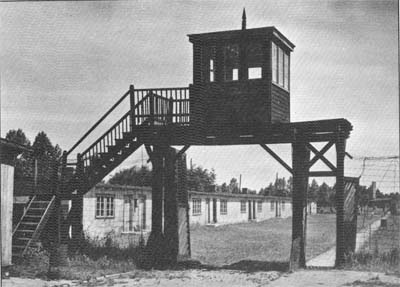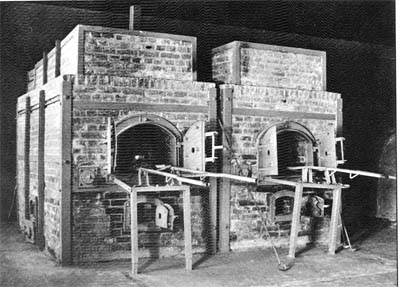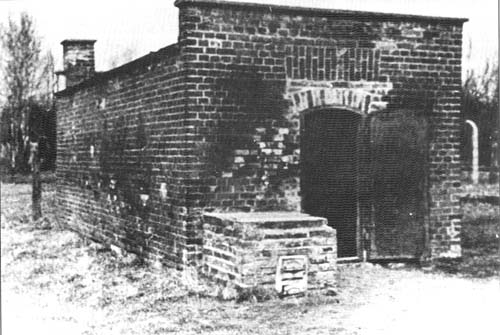|
|
 |
 |
AUSCHWITZ:
Technique
and Operation
of
the Gas Chambers © | |
|
| |
 |
Back |
 |
Contents |
Page 541 |
 |
Home
Page |
Forward |
 |
| |
 |
Photo 4:
(Personal Archives)
Entrance to the STUTTHOF
concentration camp, or rather the “old” or initial camp. At the end
of the path running from the gate is the crematorium with its high
chimney, a building reconstructed after the war. |
|
Photo 5:
(Personal Archives)
The two single-muffle
incineration furnaces of the STUTTHOF crematorium, found almost
intact at the Liberation, together with the metal stretchers for
charging the corpses, a technique developed on the basis of
experience in the Birkenau Krematorien. |
 |
|
| We crossed the Polish-Czech border at Cieszyn, before
heading for Vienna and returning to the western world that we were
beginning to miss terribly. We had came to several conclusions by
the time we left Poland: |
| |
| · |
we had discovered Polish
anti-semitism through seeing the total indifference accorded to the
places where the extermination of the Jews had taken
place; |
|
|
| · |
we deduced that there was
nothing surprising about the massacre having taken place on Polish
soil, given the ambient atmosphere |
|
|
| · |
more generally, we had come to
the conclusion that in the East, everything was GREY. |
|
|
| |
| Although I had realized that a half-day visit was not
enough to cover the whole of the Auschwitz-Birkenau complex and that
two or three days were really needed, I was one of the very few
young French people to have actually visited the site and to have
acquired some slight knowledge of the place, something that many
western historians singularly lacked. Nevertheless, my knowledge was
inadequate and in 1978-79 my topographical ignorance was to prove a
handicap. One cannot go on enjoying the irresponsibility of youth
forever. As a newly qualified pharmacist I had to make a niche for
myself and I had other things to worry about than concentration
camps. I continued to read a great deal, mainly contemporary history
and science fiction, but about the age of thirty I began to think
that I had taken in enough— receiving and understanding the thoughts
of others is a praiseworthy and necessary pastime, but in the final
analysis it becomes egotistical. It was time for me to give
something in my turn, to build something out of the knowledge I had
acquired. |
|
| |
 |
|
| |
Photo 6:
(Photo
of Polish origin taken from a work by K Dunin-Wasowicz) |
|
| |
|
|
| |
The restored gas chamber at
STUTTHOF. View of the southern end and western side. In the
foreground is the heating stove, with its chimney emerging from the
roof at the far end. This chamber, originally used for delousing
effects, was later used as a homicidal gas chamber. This mixed use
is an extreme example of the confusion created over a period of
thirty years and more by the difficulty of distinguishing between,
or the deliberate refusal to distinguish between, disinfestation and
homicidal gas chambers. |
|
|
The synthesis of my reading and my interests was to be found in
parallel history and/or political fiction. I considered the models
of the genre to be “Ce n'est pas pour cette année” by
C M Kornbluth (in Satellite, special issue 40 bis of January 1962)
dealing with the invasion of the United States by the Soviet Union
with all its consequences, and the film “L’Angleterre
occupée” showing the misadventures of a young nurse who
joins a British fascist movement and discovers the “final solution”
at the beginning of the reconquest of Britain by the Allies. Made on
a ridiculously low budget, (10 million old francs or a few tens of
thousands of dollars) this film achieved the distinction of being a
commercial failure and a total success in terms of the authenticity
of the setting, the uniforms, the military equipment which
corresponded exactly with the year of its introduction, and the
presentation of a small gas chamber in an establishment where
euthanasia was practised humanely but on a large scale — a
“clinic” where two methods of killing coexisted: lethal injections
and gas. I defy anybody to distinguish between extracts from this
film and actual sequences taken during the second world
war.
After much hesitation I came to my decision. I
would describe a universe resulting from a German victory in 1945 or
1946. I cannot claim that this was an original idea, but I wanted to
see where it would lead. In this politico-military chronicle of a
different future, I renewed the framework for my characters with
each chapter, each of which dealt with a particular question or a
specific period. unlike many novelists who set the scene once and
for all at the beginning of the book.
I eventually came to a
point where the logical continuation of my novel was via Peenemünde
and the Mazurian Lakes (literary exploitation of my holidays in
Poland), then the Balkans, in Croatia and Serbia. I wanted to go to
Zagreb, but in 1979 I was unable to manage it, despite two attempts,
so I decided to turn instead to a chapter for which I already had
documentation and personal impressions, that on
Auschwitz-Birkenau. |
| |
| *
| |
| |
AUSCHWITZ:
Technique
and operation
of the gas chambers
Jean-Claude Pressac
© 1989, The
Beate Klarsfeld Foundation |
 |
Back |
Page 541 |
Forward |
 |
|

